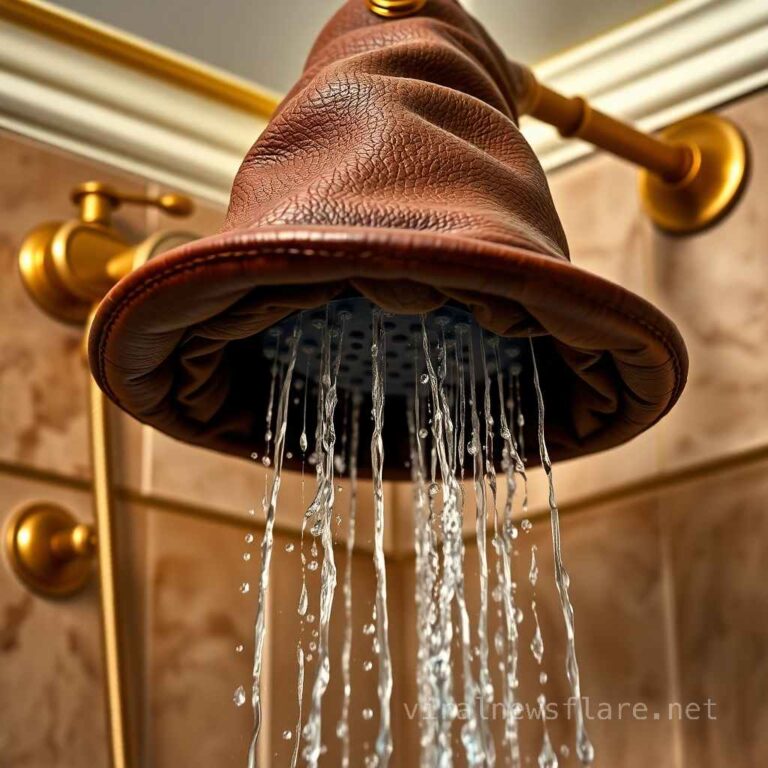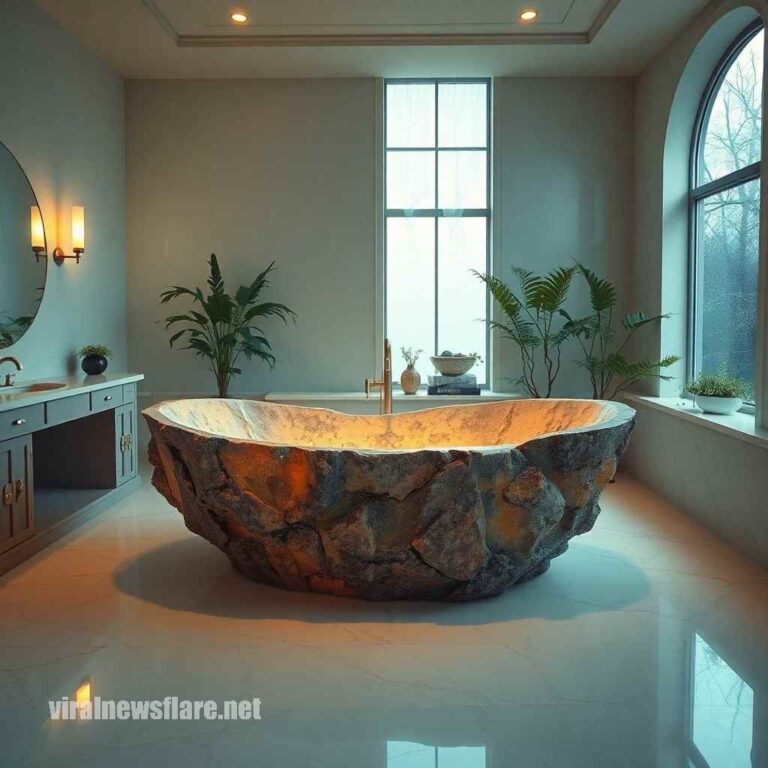A Glimpse into the Evolution of the Aquarium Staircase
The concept of embedding natural elements into architectural design is not new. For centuries, architects have drawn inspiration from nature, seeking to bring the outdoors inside and create environments that evoke feelings of peace, wonder, and connection to the natural world. However, the Aquarium Staircase takes this idea a step further by not merely referencing nature in design motifs but by literally incorporating an aquatic ecosystem into the structure of the staircase itself.
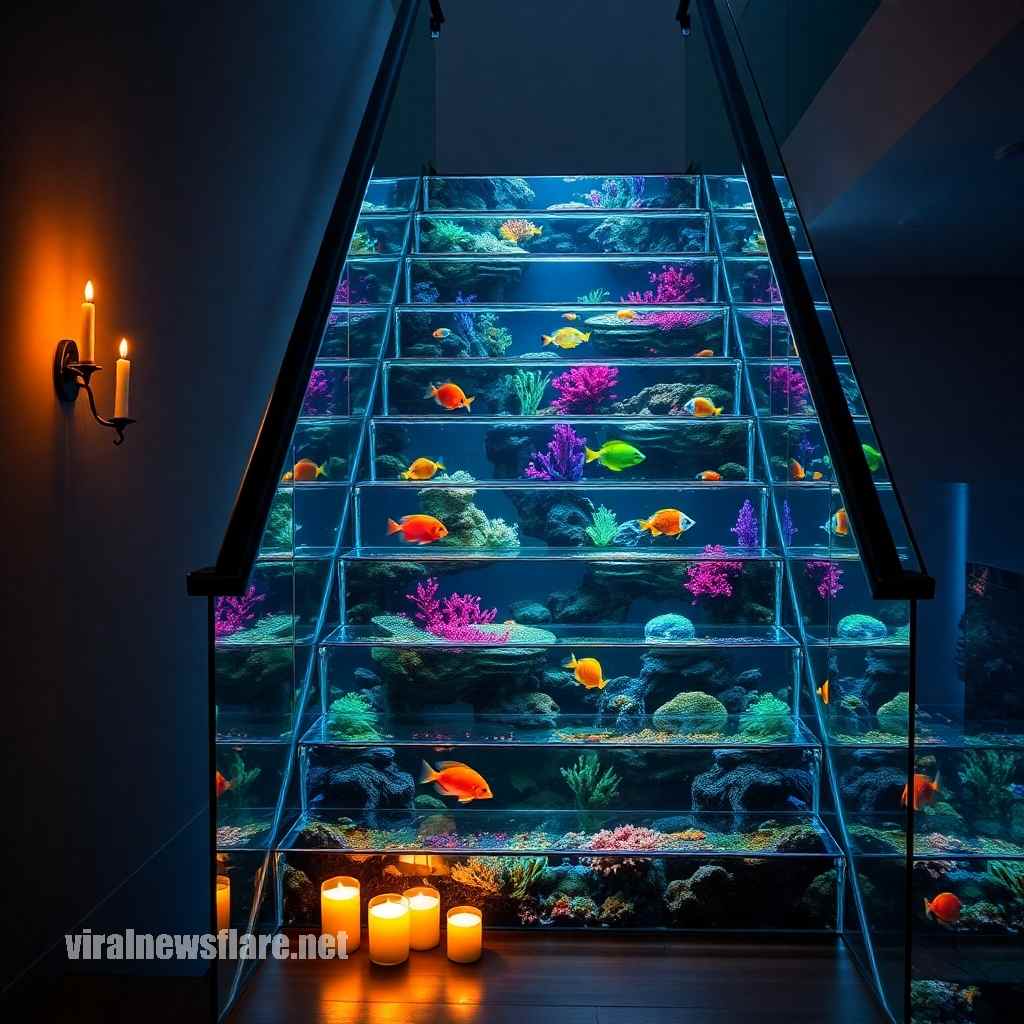
Historically, aquariums were standalone installations designed to exhibit fish and other aquatic life. As technology and design philosophies advanced, architects and designers began integrating water features into the built environment to enhance aesthetic appeal and create soothing spaces. The evolution of the Aquarium Staircase represents a pinnacle of this integration, combining the fluidity of water and the dynamism of marine life with the structural functionality of a staircase.
Architectural Innovation Embodied in the Aquarium Staircase
The Aquarium Staircase is a triumph of modern engineering and design, requiring not only an artistic eye but also an understanding of complex technical and structural challenges. At its core, an Aquarium Staircase involves a staircase that doubles as a transparent aquatic habitat. It typically features glass walls or panels that are thick, durable, and capable of withstanding significant water pressure, while also offering crystal-clear views of the underwater scene within.
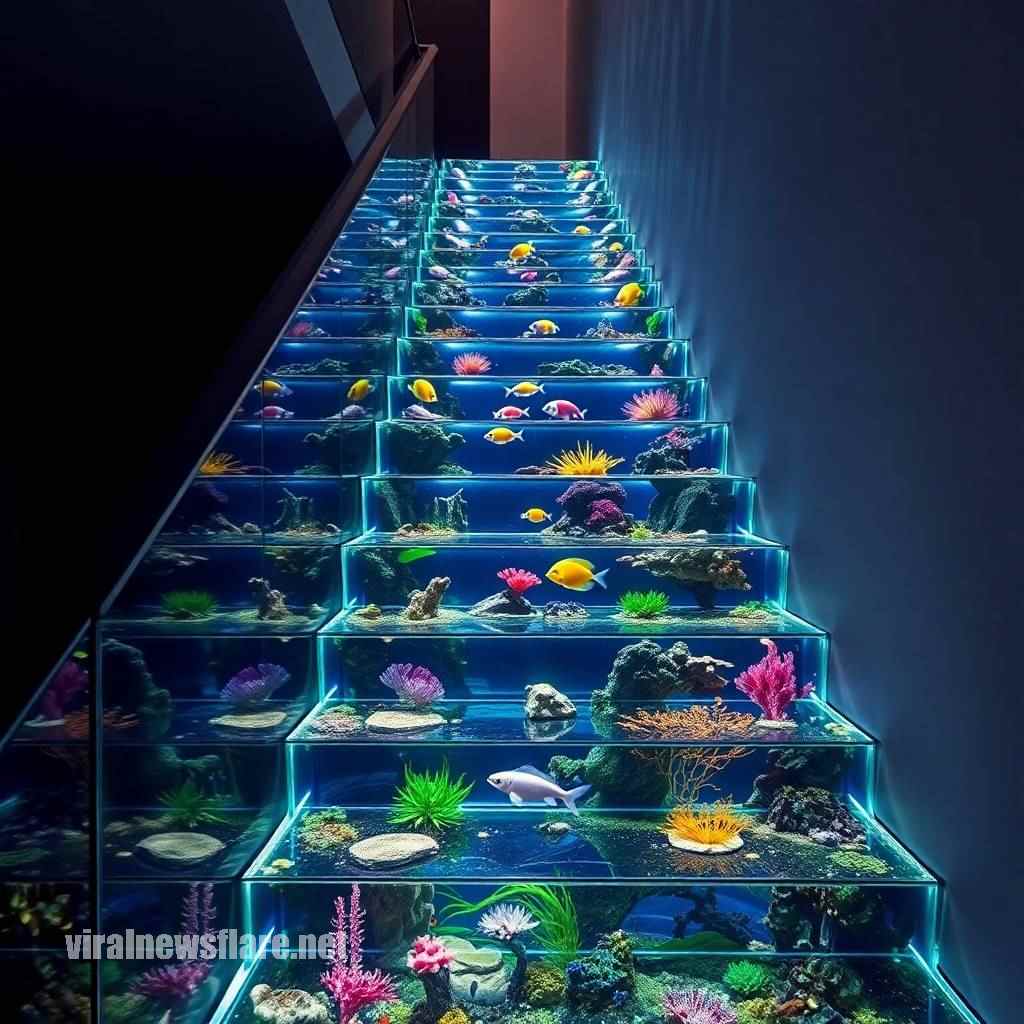
Materials and Construction
Creating an Aquarium Staircase begins with selecting the right materials. The glass used must be of the highest quality, often tempered or laminated to ensure safety and longevity. This glass is not ordinary but a special kind designed for underwater installations, capable of handling hydrostatic pressure and resisting corrosion from constant exposure to water and salt. Steel or aluminum frameworks may be used to support the weight of the structure, with waterproof seals and joints to prevent leaks and ensure stability.
Innovative construction techniques are crucial. Architects and engineers collaborate to design a seamless structure that integrates the staircase with the aquarium element without compromising either functionality or safety. Every step must be securely anchored, with non-slip surfaces that are safe for users even when they are wet. The sides of the staircase are typically composed of double-glazed panels with water sealed in between, forming the walls of the tank. This design not only provides an uninterrupted view of the underwater world but also isolates the water contained within the staircase, ensuring that it does not spill over into surrounding areas.
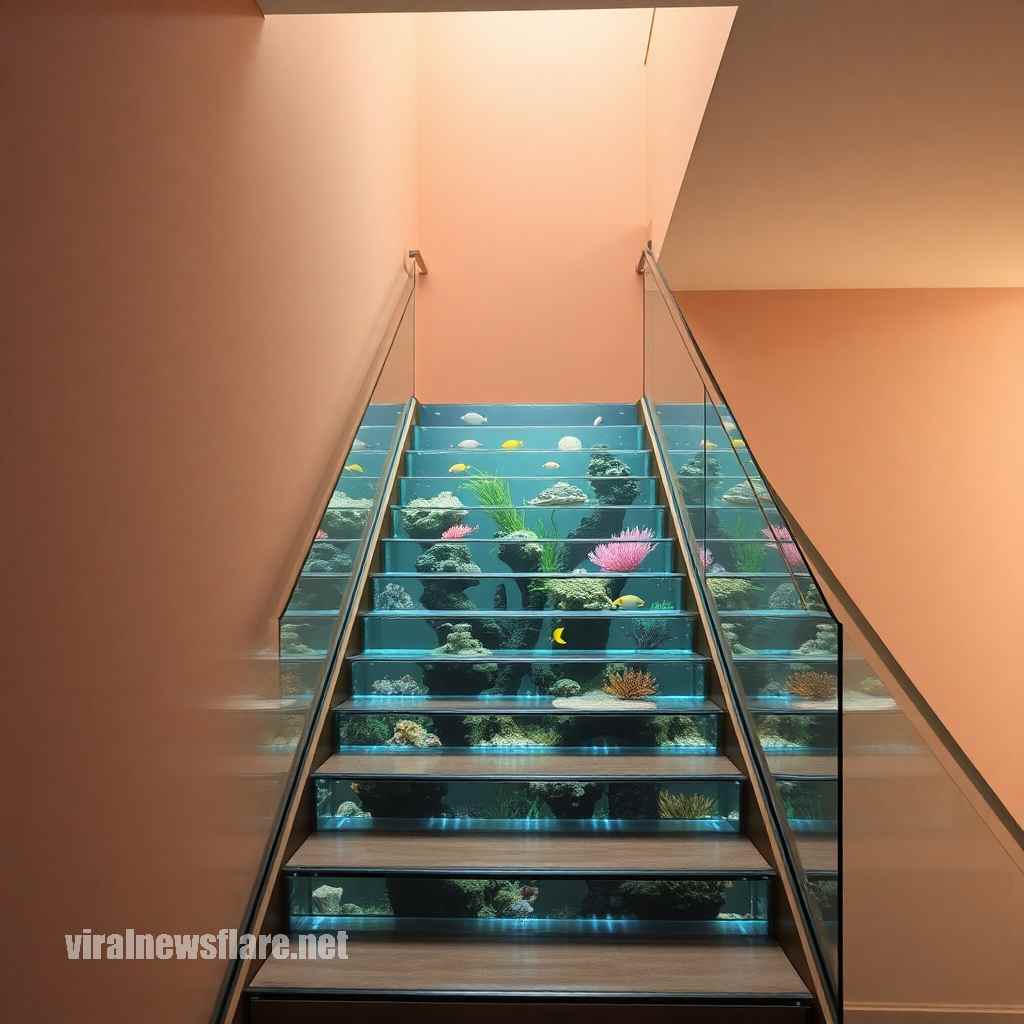
Lighting and Atmosphere
Lighting plays a pivotal role in the success of an Aquarium Staircase. Proper illumination enhances the beauty of the underwater environment, highlighting the colors and movements of marine life. LED lights are often used due to their energy efficiency, long life, and the ability to produce a range of colors that can mimic natural sunlight or create a dramatic underwater ambiance. The lighting can change gradually or in response to user movement, making the staircase a dynamic feature that evolves with the day.
The reflective quality of the glass surfaces, combined with carefully placed lighting, creates a mesmerizing interplay of light and water, contributing to the overall atmosphere of underwater tranquility. Visitors find themselves drawn into the space, feeling as though they are stepping into another world—a peaceful underwater realm that contrasts with the hustle and bustle of everyday life.
The Underwater Tranquility Experience
The phrase “underwater tranquility” is central to the Aquarium Staircase concept. It speaks to the profound sense of calm and wonder that people experience when interacting with water and aquatic life. Water has been shown to have a soothing effect on the human mind and body, often reducing stress and promoting relaxation. By integrating an aquarium directly into a staircase, designers create a space where everyday movement—ascending or descending stairs—transforms into a meditative journey through an underwater landscape.
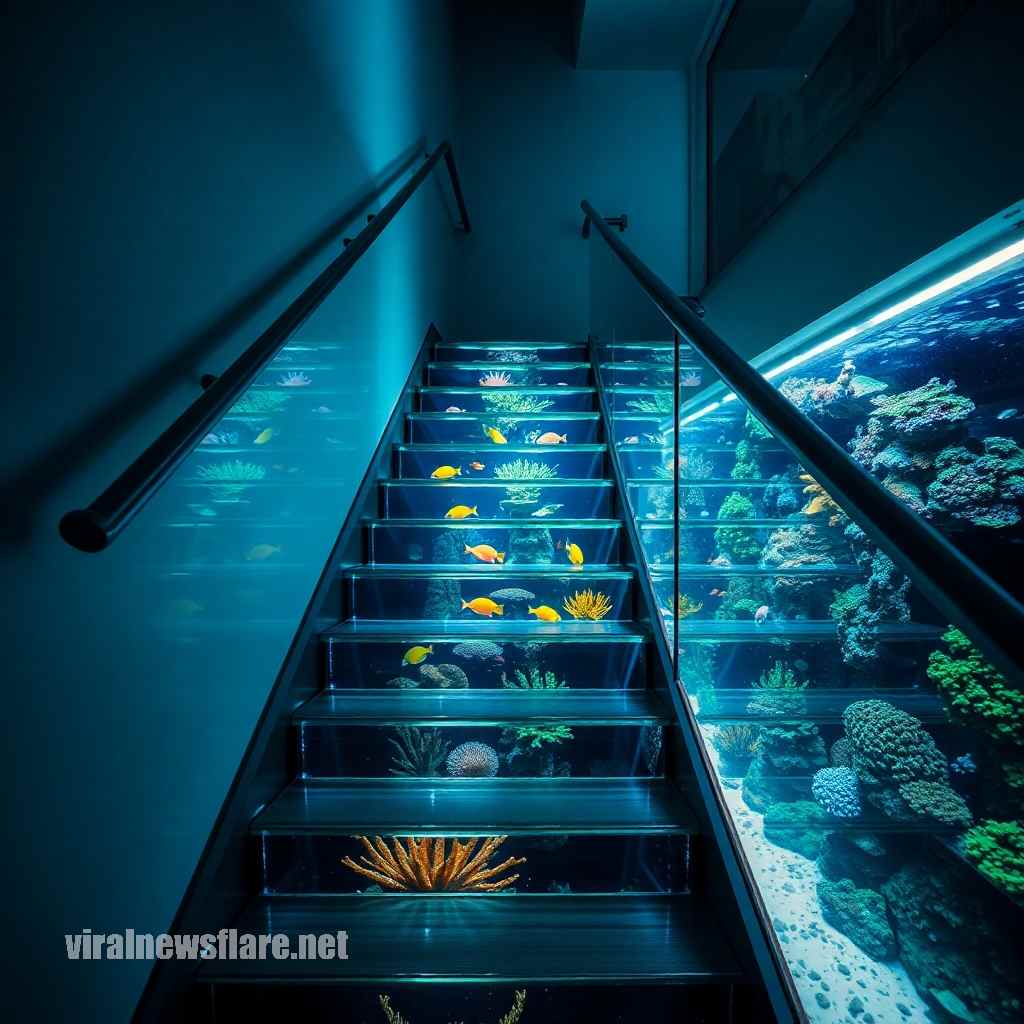
Emotional and Psychological Impact
Imagine ascending a staircase where each step brings you closer to a vibrant aquatic scene. The gentle undulation of fish, the sway of underwater plants, and the soft, filtered light penetrating the water all combine to create an environment that encourages mindfulness and relaxation. This is not just a physical ascent but a journey into a tranquil state of mind. The constant yet gentle movement of the water serves as a moving meditation, reminding visitors of the fluid nature of life and the importance of taking moments to pause and appreciate beauty.
The psychological benefits of such a space are significant. Studies have shown that exposure to natural elements—especially water—can lower blood pressure, reduce stress hormones, and improve mood. The Aquarium Staircase leverages these benefits by embedding the calming presence of water and marine life into a daily routine, offering a sanctuary of peace within an otherwise ordinary architectural feature. It becomes a place where individuals can find respite from the fast pace of modern life, reconnecting with nature in a way that is both immediate and profound.
Marrying Form and Function: Design Considerations
The genius of the Aquarium Staircase lies in its ability to serve dual purposes. It is both a functional staircase and an aesthetic masterpiece, a living artwork that enhances its surroundings. Achieving this delicate balance requires careful planning and collaboration between architects, engineers, marine biologists, and interior designers.
Structural Design and Aesthetics
The design of an Aquarium Staircase must accommodate the weight and pressure of both water and users. This necessitates a strong foundation and a robust frame to support the structure. The staircase must be designed to ensure that the integrated aquarium does not compromise safety or comfort. Each step, while integrated into an aquatic system, must provide a stable, secure platform for ascent and descent.
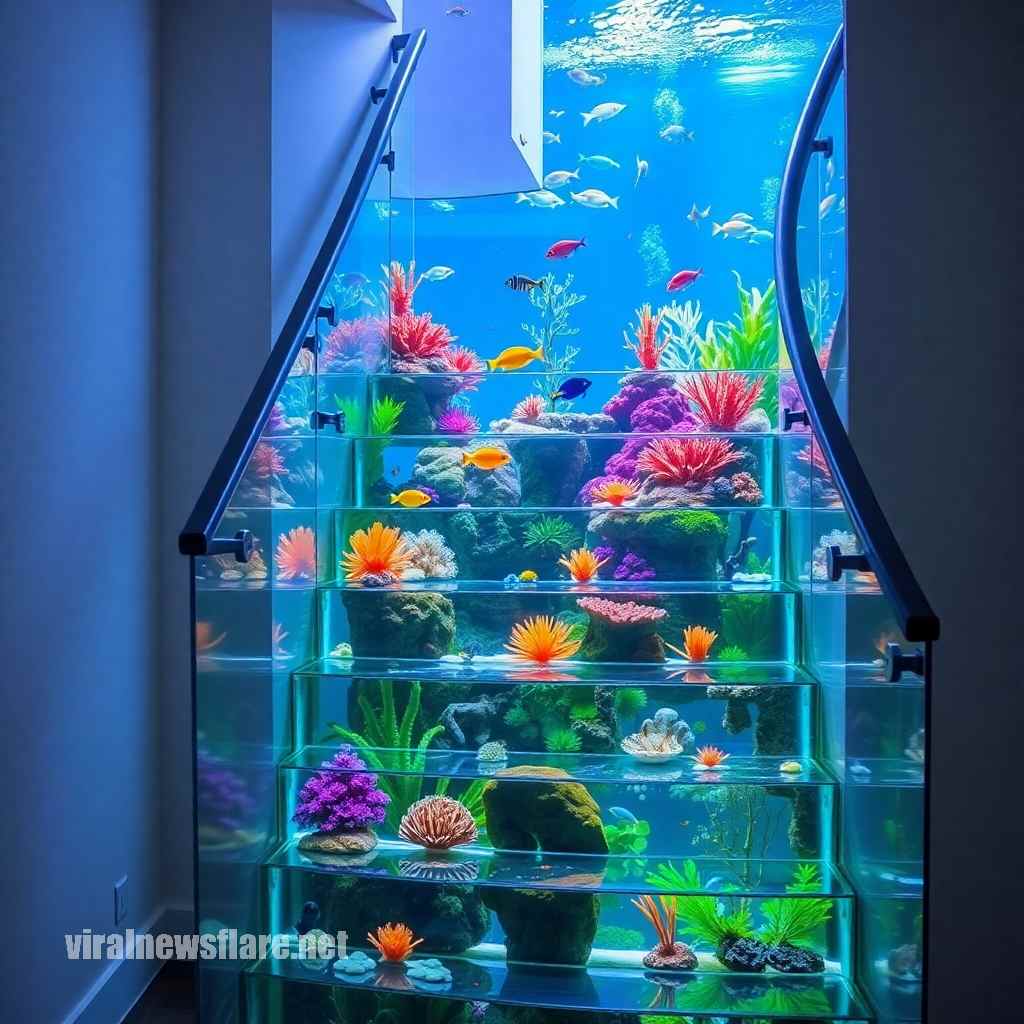
From an aesthetic perspective, the staircase should seamlessly blend into its environment. Whether placed in a modern home, a commercial building, or a public space, the Aquarium Staircase should complement the surrounding décor and architecture. Designers often use materials and finishes that echo the natural world—think of stone, wood, and earthy tones combined with the sleek transparency of glass and the fluidity of water.
The visual impact of an Aquarium Staircase is breathtaking. It offers a three-dimensional gallery of underwater life, where each step reveals a new perspective on the aquatic ecosystem. The patterns of light and shadow as water flows over the surfaces, combined with the slow, graceful movements of fish, create a dynamic tableau that changes with every moment. This ever-changing scene ensures that each visit to the staircase is a new experience, never losing its magic or allure.
Integration with Interior Design
Interior designers find the Aquarium Staircase an appealing element because of its versatility. It can serve as a focal point in a lobby, a stunning centerpiece in a home, or an interactive feature in a museum. It breaks the monotony of traditional staircases, replacing them with a conversation piece that engages visitors and enhances the spatial experience.
The Aquarium Staircase can be tailored to the specific needs and tastes of the space where it resides. For example, in a corporate setting, it could be used to symbolize innovation and forward-thinking, aligning with the company’s brand ethos. In a residential setting, it might serve as a private retreat, a space where homeowners can unwind and reflect amidst the quiet beauty of an aquatic world. The ability to customize the fish species, plant life, and decorations within the aquarium allows designers to create a personalized environment that resonates with the inhabitants or visitors.
Technical Mastery and Environmental Considerations
Building an Aquarium Staircase is not just an artistic endeavor; it is a feat of technical mastery that demands a thorough understanding of marine biology, hydrodynamics, and sustainable design practices.
Water Filtration and Maintenance
At the heart of every Aquarium Staircase lies a sophisticated ecosystem that must be maintained for the health of its aquatic inhabitants. The water must be filtered, heated, and circulated properly to mimic the natural habitats of the marine species within. Advanced filtration systems remove waste and impurities, ensuring crystal-clear water that enhances visibility and the overall aesthetic experience.
Regular maintenance is vital to preserve the delicate balance of the ecosystem. This involves monitoring water quality, checking the health of fish and plants, and ensuring that all mechanical systems—such as pumps, lights, and filtration units—are functioning correctly. The integration of smart technology allows for remote monitoring and control, with sensors that alert maintenance teams to any issues before they become problems. This proactive approach ensures that the Aquarium Staircase remains a safe and beautiful environment for both its human visitors and its aquatic residents.
Sustainability and Eco-Friendly Practices
Sustainability is a key consideration in modern architectural projects, and the Aquarium Staircase is no exception. Designers and builders often seek eco-friendly materials and energy-efficient technologies to minimize the environmental footprint of the installation.
For instance, the lighting system can incorporate LED technology with low energy consumption, and solar panels can be integrated to power part of the system, reducing reliance on external power sources. Water systems can be designed to recycle and reuse water, reducing waste and the need for constant replenishment. Additionally, choosing sustainable building materials, such as responsibly sourced glass and metal, aligns the Aquarium Staircase with broader environmental goals, ensuring that the innovation does not come at the expense of the planet.
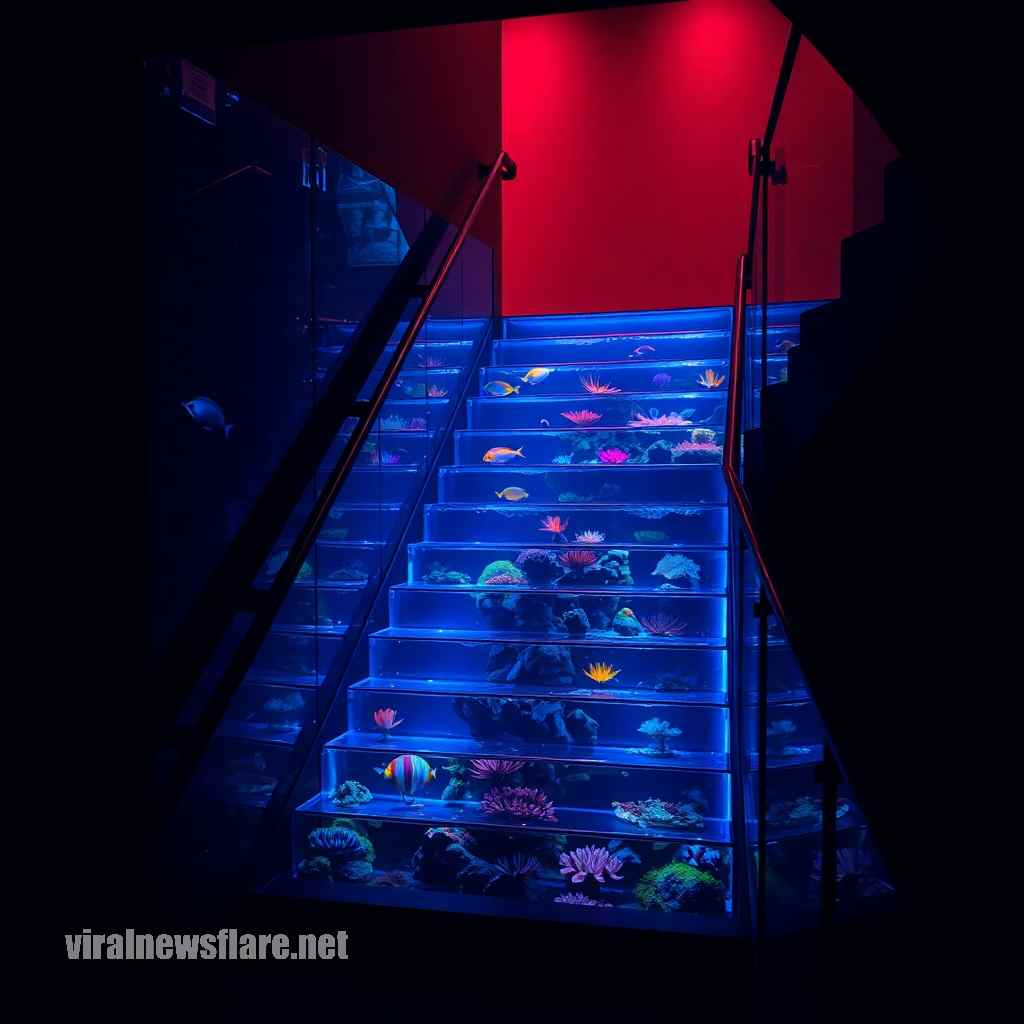
By incorporating sustainable practices, the Aquarium Staircase becomes a model for how cutting-edge design and environmental responsibility can coexist harmoniously. It not only provides an aesthetic and emotional boon but also embodies a commitment to the stewardship of natural resources, reflecting a deep respect for the very ecosystem it seeks to replicate and celebrate.
The Intersection of Technology and Nature
Technology plays an integral role in bringing the Aquarium Staircase to life. The seamless integration of digital controls, smart sensors, and automation systems creates an experience that is both magical and functional.
Smart Features and Interactive Design
Imagine stepping onto an Aquarium Staircase that senses your presence and subtly adjusts the lighting or displays interactive information about the marine life around you. With the incorporation of smart home technology, the staircase can become an interactive learning tool, providing educational content about the species swimming by, the environmental conditions of different aquatic ecosystems, or even real-time data on water quality.
These interactive elements can be enhanced with augmented reality (AR) overlays accessible via smartphones or tablets, allowing users to point their devices at different sections of the aquarium to learn more about the fish, plants, and ecosystems on display. This blend of technology and nature not only enriches the viewer’s experience but also fosters a deeper connection to the underwater world, bridging the gap between digital innovation and the organic beauty of marine life.
Future Innovations and Design Possibilities
The possibilities for the Aquarium Staircase continue to expand as technology advances. Future iterations might incorporate elements like virtual reality (VR) experiences, where users can immerse themselves in entirely different underwater worlds, or integrate with wearable technology that adjusts environmental settings based on the mood or preferences of the user.
Advancements in materials science could lead to the development of even more transparent, durable, and sustainable materials, making the construction of Aquarium Staircase designs more accessible and versatile. Innovations in robotics could allow for autonomous maintenance bots that clean the aquarium walls, adjust lighting, or feed the fish, ensuring that the system remains pristine with minimal human intervention.
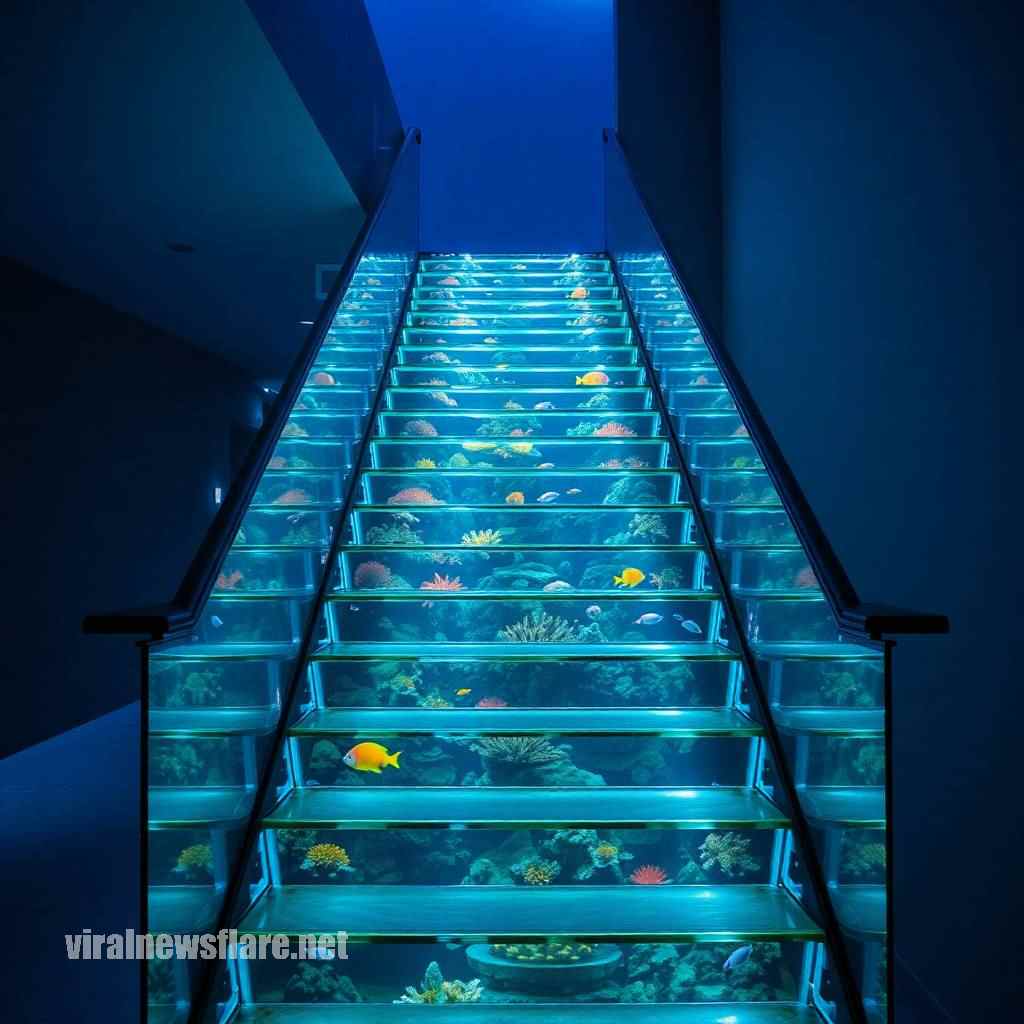
Real-World Applications and Case Studies
Throughout the world, there are several stunning examples of spaces that have successfully incorporated elements of the Aquarium Staircase concept, each uniquely tailored to its environment and purpose.
Residential Marvels
In luxury residences, homeowners are seeking unique features that set their properties apart. An Aquarium Staircase in a private home offers not only a stunning visual centerpiece but also a conversation-starting feature that reflects the owner’s taste for innovation and elegance. These installations often incorporate personalized touches—such as customized fish species, thematic decorations, or integrated seating areas—that transform the staircase into a multifunctional space where one can pause, reflect, or entertain guests in an atmosphere of underwater serenity.
Commercial and Public Spaces
Museums, hotels, and corporate lobbies are perfect venues for Aquarium Staircase installations. In museums, they can serve as educational exhibits, demonstrating principles of marine biology and environmental science in an interactive format. Hotels and corporate buildings use these installations to create memorable experiences for guests and clients, symbolizing a commitment to innovation, sustainability, and the integration of nature into everyday life.
For example, imagine a hotel lobby where a grand staircase features a panoramic aquarium, with schools of fish swimming amidst coral replicas. The calming effect of the underwater scene can reduce the stress of travelers while simultaneously showcasing the establishment’s dedication to luxury and design excellence.
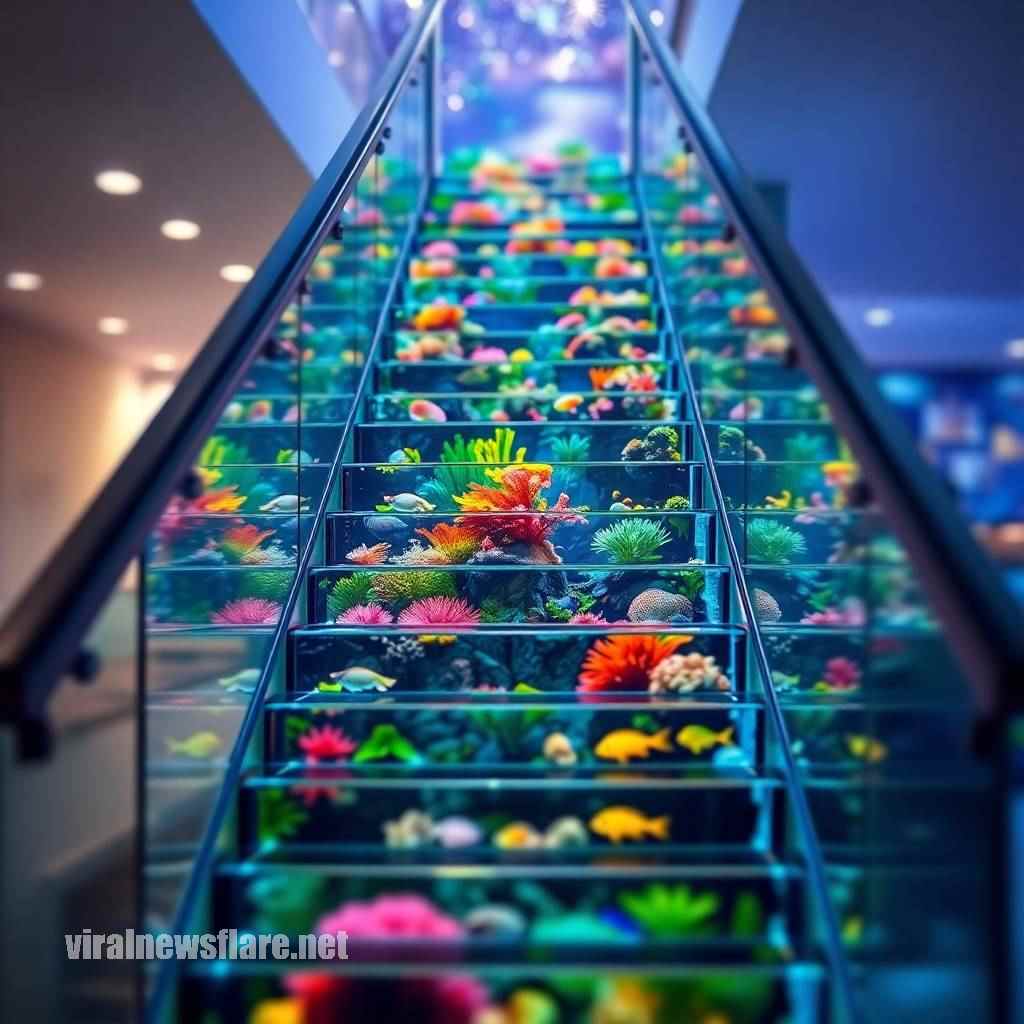
Challenges and Solutions in Creating an Aquarium Staircase
While the Aquarium Staircase concept is undeniably captivating, it comes with its own set of challenges. Addressing these challenges requires creative problem-solving, rigorous planning, and a deep understanding of both architectural principles and marine ecosystems.
Engineering and Safety Concerns
The integration of large bodies of water into a staircase structure introduces significant engineering challenges. The weight of the water, the need for leak-proof construction, and the safety of users require meticulous design. Engineers must account for the forces exerted by water at different levels of the staircase and ensure that the structure can withstand these pressures over time. Advanced modeling software and simulations are often used to test designs under various conditions before construction begins.
Safety is paramount. The glass walls must not only be strong enough to hold the water but also be shatterproof to prevent accidents. Non-slip surfaces on the steps, waterproof electrical components, and emergency shut-off systems for pumps and lights are all essential features that protect users and maintain the integrity of the aquarium ecosystem.
Maintenance and Long-Term Sustainability
Maintaining an Aquarium Staircase requires ongoing commitment. Regular cleaning of the glass to prevent algae buildup, periodic water changes, and monitoring of filtration systems are all part of the upkeep. To address these challenges, many designs incorporate automated cleaning systems, remote monitoring sensors, and modular components that can be easily replaced or repaired.
By planning for long-term sustainability from the outset—using durable materials, designing for energy efficiency, and integrating user-friendly maintenance technologies—designers ensure that the Aquarium Staircase remains a vibrant, functioning piece of art for years to come.
The Symbolic Significance of the Aquarium Staircase
Beyond its physical presence, the Aquarium Staircase carries deep symbolic meaning. It represents a journey from one state to another, much like the transition one experiences when encountering a different world or state of mind. As a staircase, it facilitates movement and progression; as an aquarium, it invites contemplation and reflection. The merging of these functions creates a space where every step taken is both literal and metaphorical—ascending not only through physical levels but also towards greater peace, understanding, and connection with nature.
This symbolism extends to the broader conversation about how humans relate to their environment. In a world increasingly disconnected from nature due to urbanization and technology, the Aquarium Staircase serves as a reminder of the importance of integrating natural elements into our built environment. It encourages us to slow down, observe, and appreciate the beauty that lies beneath the surface, both in the watery depths and within ourselves.
The Aquarium Staircase stands at the crossroads of architectural innovation and underwater tranquility. It is a testament to human creativity, where engineering prowess and artistic vision converge to produce spaces that uplift, inspire, and soothe. Through careful consideration of materials, design, technology, and sustainability, the Aquarium Staircase transforms a mundane architectural element into a living ecosystem, a dynamic work of art that invites us to experience the serenity of underwater life in our daily routines.
As we move forward into an era that values both technological advancement and environmental harmony, concepts like the Aquarium Staircase become beacons of what is possible when we dare to blend imagination with science, functionality with beauty. They remind us that architecture can be a pathway—not just between floors, but between realms of experience—connecting us to nature in ways that are both innovative and profoundly peaceful.
